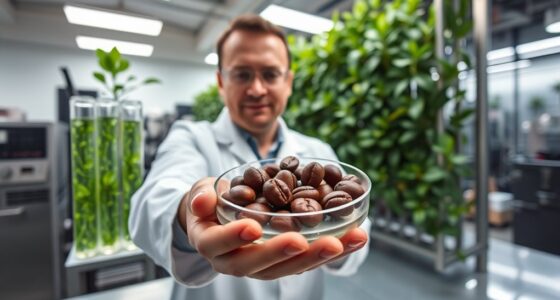Chlorogenic acids are natural compounds in coffee that influence its flavor and health benefits. They add brightness and acidity but can also cause bitterness if over-extracted or roasted too dark. Light roasts preserve more CGAs, giving a lively, tangy taste, while darker roasts reduce them, mellowing flavors. Whether they’re friends or foes depends on your flavor preferences and health goals, and understanding their role helps you choose the perfect brew. Keep exploring to learn more.
Key Takeaways
- Chlorogenic acids contribute to coffee’s brightness, acidity, and complex flavor profile, enhancing overall sensory experience.
- During roasting, chlorogenic acids break down, reducing acidity and leading to smoother, less tangy coffee flavors.
- High chlorogenic acid levels can increase perceived bitterness and sourness, potentially overpowering desirable flavors.
- Proper roasting preserves some chlorogenic acids, balancing health benefits with flavor without compromising quality.
- The influence of chlorogenic acids on flavor depends on bean origin, processing, and roasting level, acting as both a flavor enhancer and a challenge.
What Are Chlorogenic Acids and Where Do They Come From?

Chlorogenic acids are naturally occurring compounds found in many plants, especially in coffee beans, fruits, and vegetables. Their origin of chlorogenic acids traces back to plant biochemistry, where they serve essential roles in plant defense and growth. These acids are esters formed between certain hydroxycinnamic acids and quinic acid, produced through complex biosynthetic pathways within plants. During plant development, chlorogenic acids help protect against pathogens and UV radiation, contributing to the plant’s overall health. In coffee, these compounds accumulate in the beans during ripening and processing. Understanding the origin of chlorogenic acids in plant biochemistry reveals their importance in plant physiology, as well as their influence on coffee’s chemical composition and potential health benefits for humans. Understanding plant biosynthesis provides further insight into how these compounds are naturally produced and their significance in plant survival.
How Do CGAs Affect Coffee’s Flavor Profile?

You’ll notice that chlorogenic acids can influence coffee’s flavor by adding a bitter and tangy note. As these acids break down during roasting, they also challenge flavor preservation, making it tricky to maintain balance. Understanding how CGAs impact bitterness and acidity helps you appreciate the complexities behind your favorite brew. Additionally, the antioxidant properties of CGAs may contribute to subtle flavor nuances, further complicating the overall taste profile.
Bitterness and Acidity
Because chlorogenic acids (CGAs) break down during coffee roasting, they play a significant role in shaping the beverage’s bitterness and acidity. When you choose brewing methods like espresso or cold brew, you influence how much CGA remains, affecting the overall flavor. A shorter roast preserves more CGAs, resulting in a brighter, more acidic cup with noticeable bitterness. Conversely, darker roasts reduce CGA content, mellowing acidity but increasing bitterness. Proper storage techniques also matter; storing coffee in airtight containers away from light slows CGA degradation, maintaining a balanced acidity. If you want a lively, tangy flavor, opt for fresher beans and lighter roasts. Understanding how brewing and storage impact CGA levels helps you control the bitterness and acidity in your coffee. Additionally, color accuracy during roasting can influence how vividly the acidity and bitterness are perceived in the final taste.
Flavor Preservation Challenges
Maintaining the vibrant flavor of coffee can be challenging because CGAs influence both brightness and bitterness, which are key to a well-balanced cup. Harvest timing critically impacts CGA levels; picking beans too early or late alters their concentration, affecting flavor stability. Proper storage methods are equally essential—exposing beans to heat, light, or humidity accelerates CGA degradation, dulling brightness and increasing undesirable bitterness. To preserve flavor, you should store coffee in airtight containers in a cool, dark place, minimizing environmental exposure. Additionally, selecting ideal harvest times ensures the beans retain desirable CGA content, supporting a lively, well-rounded profile. Managing these factors helps maintain the delicate balance of acidity and bitterness, ensuring your coffee remains flavorful from farm to cup. Understanding coffee storage is crucial for preventing flavor loss and maintaining freshness over time.
The Impact of Roasting on Chlorogenic Acids

When you roast coffee, the level of roasting directly influences the chlorogenic acid content. As roasting progresses, these acids break down more rapidly, altering the coffee’s health benefits and flavor. Understanding these degradation dynamics helps you choose the right roast for your preferred balance of taste and acidity. Additionally, antioxidant properties of chlorogenic acids may diminish with darker roasts, impacting their potential health benefits.
Roasting Level Effects
Have you ever wondered how the roasting process influences chlorogenic acids in your coffee? The level of roasting substantially impacts their concentration. Light roasts tend to preserve more chlorogenic acids because they undergo less heat exposure, maintaining brighter, more acidic flavors. As you increase the roast level, these acids break down, resulting in smoother, less acidic profiles. Bean origin also plays a role; some beans naturally contain higher chlorogenic acid levels, which react differently during roasting. Additionally, your brewing method influences how much chlorogenic acid you extract. For example, pour-over and AeroPress tend to highlight acidity, emphasizing the acids retained in lighter roasts, while espresso, with its intense extraction, can draw out more of these compounds, even in darker roasts. Understanding how processing techniques affect chlorogenic acids can help you tailor your coffee experience to your taste preferences.
Acid Degradation Dynamics
Ever wondered how roasting transforms chlorogenic acids in your coffee? During roasting, heat causes significant acid degradation, reducing chlorogenic acid content. The extent depends on processing methods—light roasts preserve more acids, while darker roasts break them down further. Roasting temperature and duration directly influence acid degradation dynamics, shaping flavor profiles. Storage stability also plays a role; exposed to oxygen or moisture, chlorogenic acids can degrade even after roasting, altering coffee’s freshness and health benefits. Understanding these dynamics helps you manage how acids impact flavor and antioxidant properties. By controlling roasting levels and storing coffee properly, you can influence the balance of chlorogenic acids, ensuring your brew maintains its desired qualities over time. Cold-pressed vegetable juice techniques can help preserve nutrients and antioxidants in your coffee beans, potentially influencing their health benefits.
Balancing Brightness and Bitterness in Coffee

Balancing brightness and bitterness in coffee is essential to achieving a harmonious flavor profile that appeals to your palate. When you focus on flavor balance, you enhance your sensory perception, making each sip more enjoyable. Brightness, often from acidity, provides lively, fruity notes that energize the palate. Conversely, bitterness adds depth and complexity, preventing the coffee from tasting flat. To strike the right balance, consider adjusting brewing methods, grind size, and roast level, which influence how chlorogenic acids and other compounds develop. A well-balanced coffee offers clarity without harshness, allowing the nuanced flavors to shine through. Understanding how chlorogenic acids influence taste can help you tailor your brewing process for optimal flavor. By fine-tuning these elements, you ensure your coffee experience is both vibrant and smooth, satisfying your taste and elevating your appreciation for the craft behind each cup.
The Health Implications of Chlorogenic Acids

Chlorogenic acids in coffee are increasingly recognized for their potential health benefits, making them a remarkable component of your daily beverage. These compounds work in caffeine synergy, enhancing your alertness while providing antioxidant benefits that may reduce oxidative stress. Studies suggest chlorogenic acids can support metabolic health, help regulate blood sugar levels, and even contribute to weight management. Their antioxidant properties help neutralize harmful free radicals, lowering your risk of chronic diseases. Additionally, research indicates that chlorogenic acids may influence gut health by promoting beneficial microbial activity in the digestive system. While high consumption may cause minor side effects like stomach discomfort, moderate intake is generally safe and beneficial. Incorporating coffee rich in chlorogenic acids can boost your overall health, making it more than just a flavorful pick-me-up; it’s a functional beverage supporting your well-being.
Choosing Coffee Beans Based on Chlorogenic Acid Content

When selecting coffee beans to maximize chlorogenic acid intake, it’s important to contemplate their origin, processing methods, and roast level. Beans from different regions, like Central America or Africa, often have higher chlorogenic acid levels, influencing your choice for health benefits. Light roasts tend to preserve more chlorogenic acids, but they can alter the flavor balance, making the coffee more acidic and brighter. Dark roasts reduce chlorogenic acid content, resulting in smoother, bolder flavors but less of these compounds. Your bean selection should align with your taste preferences and health goals. If you want a balanced flavor with higher chlorogenic acids, opt for lightly roasted beans from regions known for their acid content. This way, you can enjoy both flavor and potential health benefits. Understanding coffee chemistry can further help tailor your choice to optimize chlorogenic acid retention.
Frequently Asked Questions
Do All Coffee Types Contain the Same Levels of Chlorogenic Acids?
You’ll find that not all coffee types contain the same levels of chlorogenic acids. Varietal differences, such as Arabica versus Robusta, influence acid content, with Robusta generally having more. Roasting impacts these levels too; lighter roasts retain more chlorogenic acids, while darker roasts reduce them. So, depending on the coffee’s type and roasting process, your cup can vary markedly in chlorogenic acid content.
Can Brewing Methods Influence Chlorogenic Acid Retention?
Brewing methods definitely influence chlorogenic acid retention. You can maximize their preservation by controlling brewing temperature and extraction efficiency. Higher temperatures tend to break down acids, so lower heat preserves more chlorogenic acids. Efficient extraction ensures you get these compounds without over-extracting bitter flavors. So, if you want more chlorogenic acids in your coffee, opt for brewing techniques that balance temperature and extraction carefully.
Are There Culinary Uses for Chlorogenic Acids Outside Coffee?
You might be surprised to learn that chlorogenic acids have culinary uses beyond coffee. They’re explored in alternative health applications for their antioxidant properties and can serve as natural preservatives in food. You can incorporate them into smoothies, herbal infusions, or baked goods to boost health benefits. Their potential to extend shelf life makes them a versatile option in the kitchen, adding both flavor and functional value.
How Do Chlorogenic Acids Affect Coffee’s Shelf Life?
You might notice that chlorogenic acids impact coffee’s shelf life by undergoing chlorogenic acid oxidation over time. This process leads to flavor deterioration, making your coffee taste flat or stale. To preserve freshness, store coffee in airtight containers away from light and heat, which slows chlorogenic acid oxidation. By doing so, you help maintain the vibrant flavors and extend the coffee’s enjoyable shelf life.
Is There an Optimal Chlorogenic Acid Level for Flavor Balance?
You might be surprised to learn that about 70% of coffee’s flavor comes from chlorogenic acids, making their level essential. Finding the ideal balance ensures your brew has a rich, smooth flavor profile without bitterness. Too much can dull the taste, while too little may reduce complexity. Adjusting chlorogenic acids helps you craft a coffee with the perfect harmony, enhancing your overall tasting experience.
Conclusion
Now that you know how chlorogenic acids influence coffee’s flavor and health, you can make smarter choices to suit your taste and wellbeing. Whether you prefer a brighter, more acidic brew or a smoother cup, understanding CGAs helps you find the perfect balance. Don’t put all your eggs in one basket—explore different beans and roasting levels to craft your ideal coffee. After all, the proof of the pudding is in the tasting!









